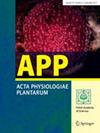Exogenous jasmonic acid increases Barringtonia racemosa tolerance to heavily lead-contaminated soil
Abstract
Highly toxic lead (Pb) is essentially a threat to the ecological security of mangrove wetlands in the South China Sea. Barringtonia racemosa is a typical and endangered semi-mangrove, which may be suffering from heavy Pb pollution. Jasmonic acid (JA) can regulate plant defense mechanisms under Pb stress. This study explored the defense and adaptive mechanisms of B. racemosa under the regulation of JA through controlled experiments with a Pb concentration gradient. Results showed that exogenous JA significantly increased the palisade tissue and root cortex thickness of B. racemosa under different Pb concentrations, while the thickness of the vascular bundle diameter had the opposite response. Peroxidase activity, proline and chlorophyll concentrations were significantly increased under Pb stress. It can be concluded that increasing palisade tissue thickness, concentrations of photosynthetic pigments and antioxidant enzymes are aided by JA and constitute a vital Pb-stress response strategy for B. racemosa. JA enhanced antioxidant defense mechanisms, mitigating Pb toxicity and reducing reactive oxygen species produced under heavy Pb stress. Remarkably, under high Pb concentration, the bioconcentration factor and Pb absorption of B. racemosa were significantly reduced, improving its tolerance to Pb stress. This study revealed the regulatory mechanism of the exogenous hormone JA on the tolerance of B. racemosa under Pb stress, which has a scientific guiding significance for the protection of germplasm resources of B. racemosa in the heavily Pb-polluted areas of mangrove wetlands.

 求助内容:
求助内容: 应助结果提醒方式:
应助结果提醒方式:


